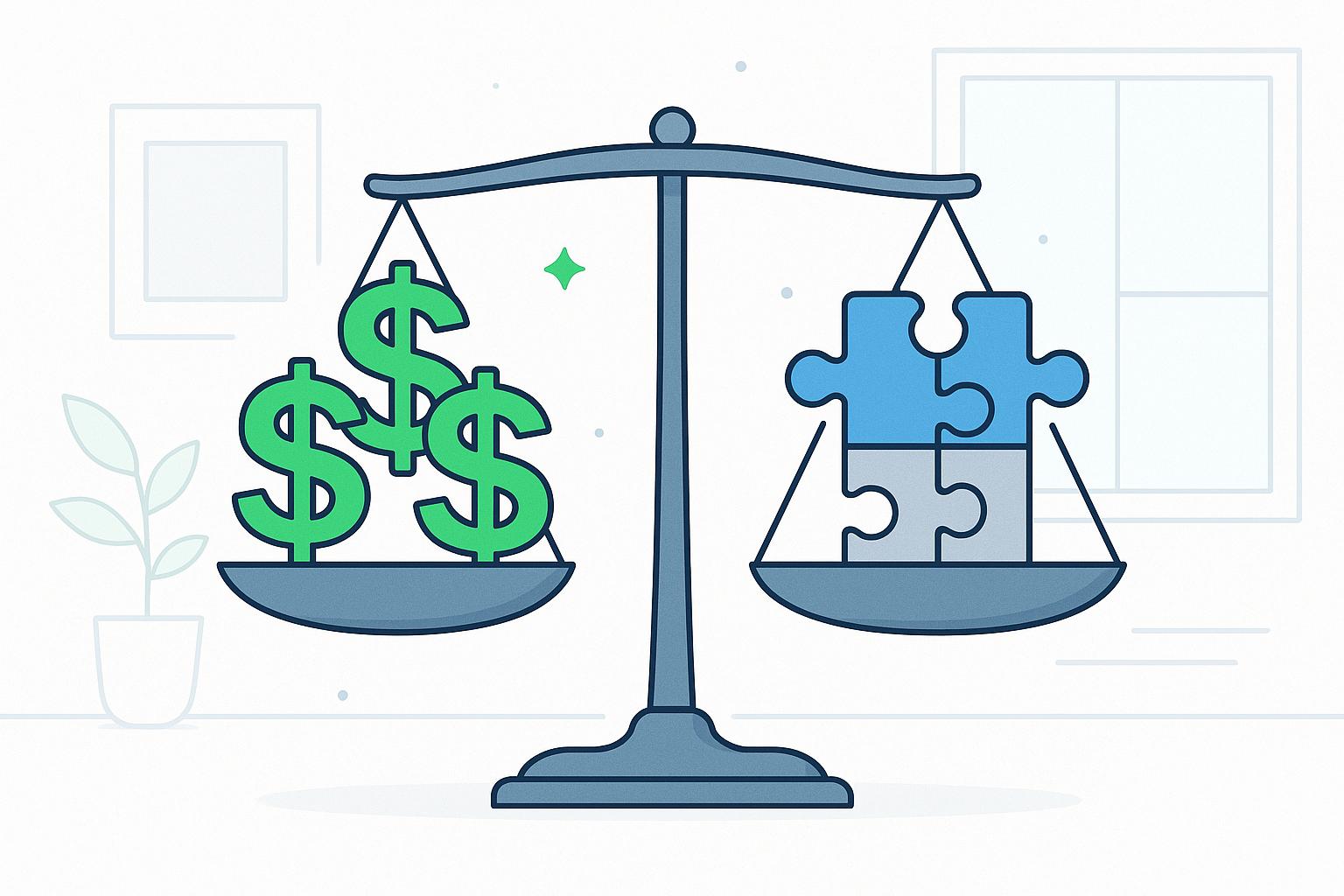Funding gap analysis is crucial for financial planning, and organizations can choose between two main approaches: manual methods or AI tools. Here's a quick breakdown:
- Manual Methods: Relies on human expertise to analyze financial data, offering flexibility and deep contextual understanding. However, it’s time-consuming, prone to errors, and struggles with large datasets.
- AI Tools: Automates data processing, delivers real-time insights, and handles complex datasets efficiently. But it requires quality input data and lacks the nuanced judgment of human analysts.
Quick Comparison:
| Feature | Manual Methods | AI Tools |
|---|---|---|
| Speed | Slow | Instant results |
| Accuracy | Prone to errors | High precision |
| Data Handling | Limited capacity | Processes large datasets easily |
| Cost | Low upfront, high ongoing | High upfront, low ongoing |
| Contextual Insight | High | Limited |
Best Approach? Combine both: Use AI for efficiency and human expertise for strategic decisions.
How AI Will Transform Accounting: A $100B Opportunity
Manual Methods for Funding Gap Analysis
Manual methods play a key role in funding gap analysis, offering insights through human expertise. Understanding their strengths and limitations helps highlight how AI tools can bring improvements.
Overview of Manual Processes
Manual funding gap analysis involves tasks like reviewing financial statements, forecasting, and comparing funding needs with available resources. Analysts take into account factors such as seasonality, economic trends, and market conditions to develop detailed budgets [3][5].
Benefits of Manual Methods
One major strength of manual methods is the ability to apply human judgment. Experienced analysts can interpret subtle market trends and industry-specific nuances that might not be evident in raw data.
| Benefit | Description |
|---|---|
| Human Insight | Analysts factor in qualitative elements and align decisions with business goals. |
| Flexibility | Processes can be tailored to fit unique business needs and specific challenges. |
Challenges of Manual Methods
Manual approaches can be time-consuming, error-prone, and struggle with processing large or complex datasets [1][4]. Tasks like analyzing seasonal cash flow or modeling multiple growth scenarios often push manual methods beyond their limits. This becomes even more problematic when working with real-time or large-scale financial data, where speed and scalability are essential.
While human expertise is at the core of manual methods, AI tools are designed to overcome these challenges by automating data processing and boosting efficiency.
AI-Based Tools for Funding Gap Analysis
How AI Tools Analyze Funding Gaps
AI tools are transforming how funding gaps are analyzed. Using machine learning, these tools process massive amounts of financial data to predict funding shortfalls and suggest ways to address them [1][4]. By analyzing real-time data, they can uncover patterns that might escape human attention.
These tools connect with financial systems, apply machine learning techniques to identify trends, and use predictive models to estimate future funding needs.
Features of AI Tools
AI platforms for funding gap analysis come packed with features designed to simplify and improve the process. For example, tools like Lucid Financials integrate seamlessly with financial systems to deliver actionable insights, automate complex modeling tasks, and identify funding gaps more effectively.
Key features include:
- Automated modeling for scenario planning and funding analysis
- Industry benchmarking to compare performance with peers
- Real-time monitoring enabled by system integrations
While these features make the process faster and more precise, they also bring certain challenges that users should be aware of.
Strengths and Drawbacks of AI Tools
To use AI tools effectively, it's important to weigh their benefits against their limitations.
| Aspect | Strengths | Drawbacks |
|---|---|---|
| Data Handling | Handles large datasets and complex scenarios quickly | Requires high-quality input data |
| Decision Support | Provides continuous monitoring and alerts | Lacks deep contextual understanding |
| Integration | Connects smoothly with existing systems | May face compatibility issues |
The performance of these tools heavily depends on the quality of the data they process and how well their parameters are configured. While they excel at crunching numbers, they often miss qualitative insights that experienced analysts can identify. This highlights the need for human involvement to address areas where AI might fall short, ensuring a balance between automation and strategic decision-making.
sbb-itb-17e8ec9
Comparing AI Tools and Manual Methods
Pros and Cons of Each Approach
When deciding how to tackle funding gap analysis, it's important to weigh the strengths and weaknesses of AI-driven tools versus manual methods. Here's a side-by-side look:
| Aspect | AI Tools | Manual Methods |
|---|---|---|
| Speed | Delivers results instantly | Takes significant time to process |
| Accuracy | High precision, fewer mistakes | More prone to human error |
| Data Handling | Processes massive datasets with ease | Limited by human capacity |
| Cost | High upfront investment but lower ongoing costs | Low initial cost but higher long-term expenses |
| Adaptability | Quickly adjusts to changes automatically | Better suited for unique or complex scenarios |
| Contextual Understanding | Lacks deep understanding of context | Excels in qualitative and contextual analysis |
| Integration | Connects seamlessly with systems | Requires manual data entry and collection |
| Resources Needed | Requires technical expertise | Relies heavily on labor and time |
Deciding on the Best Approach
Choosing between these methods depends largely on your organization's specific needs and capabilities:
When AI Tools Make Sense
AI tools are ideal if you:
- Work with large, complex datasets that need frequent analysis
- Require real-time insights to make timely decisions
- Have the infrastructure to support AI solutions
- Can afford the initial investment in technology
For example, platforms like Lucid Financials showcase how AI tools can simplify funding gap analysis with features like instant insights and scenario simulations.
When Manual Methods Are Better
Manual methods might be the way to go if you:
- Only need occasional or straightforward analysis
- Value deep contextual understanding in your evaluations
- Have limited access to advanced technology
- Face scenarios that demand specialized, human-driven attention
The Hybrid Option
Blending both approaches often yields the best results. Use AI to handle repetitive tasks and large-scale data processing, while relying on human expertise for strategic decisions and nuanced interpretations. This combination helps you balance efficiency with depth, leveraging the best of both worlds.
Ultimately, the right choice - or mix - depends on your organization's goals, available resources, and the complexity of your analysis needs.
Conclusion
Summary of Key Points
Funding gap analysis has seen major advancements with the integration of AI alongside traditional methods. AI provides speed and accuracy, while manual approaches add critical human judgment. Combining these two creates a well-rounded strategy for financial planning, leveraging AI's efficiency without losing the depth of human expertise.
Next Steps
Organizations can take actionable steps to improve their funding gap analysis:
- Evaluate Current Processes: Identify areas causing delays or inefficiencies. Research AI tools that align with your specific needs, such as platforms like Lucid Financials, which integrate smoothly with existing systems [1].
- Adopt a Balanced Approach: Use AI for tasks like real-time data analysis, automated scenario modeling, and frequent forecasting. Save manual efforts for strategic decisions, nuanced analysis, and relationship-driven planning.
Blending AI capabilities with human insight creates a robust framework for financial planning, helping organizations make informed decisions and achieve long-term growth.
FAQs
Can AI do gap analysis?
AI tools can analyze funding gaps by connecting with financial systems, spotting patterns, and predicting potential shortfalls. This allows organizations to tackle funding issues faster than with older methods.
For example, Lucid Financials uses AI to automate scenario modeling and provide instant insights into funding gaps. This helps organizations make timely financial decisions. The platform also integrates with existing financial systems, ensuring continuous monitoring and proactive identification of gaps [1][2].
Here’s what sets AI-powered gap analysis apart:
| Aspect | What It Does |
|---|---|
| Data Integration | Links to financial systems for real-time tracking |
| Forecasting | Identifies potential gaps based on past data |
| Automation | Simplifies repetitive analysis tasks |
While AI can process complex financial data quickly and accurately, the best results come from pairing these tools with human expertise. This combination ensures efficient analysis and well-rounded financial planning [1][3].


